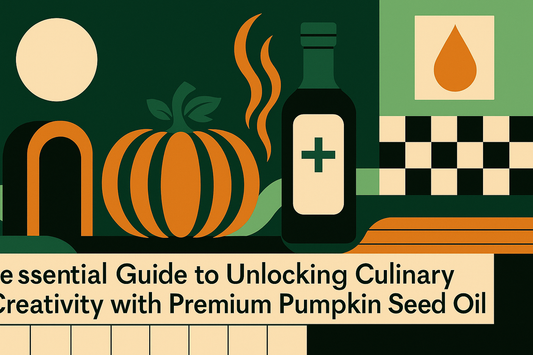
The Pumpkin Seed Oil vs. Grape Seed Oil Debate: Which Is Right for You?
Introduction
Natural oils have captured the interest of home chefs and wellness enthusiasts alike. In recent years, a thoughtful debate has emerged between two notable specialty oils: pumpkin seed oil and grape seed oil. This discussion explores their origins, nutritional profiles, and culinary characteristics to provide a balanced view that can guide choices based on personal kitchen and lifestyle goals.
Overview of Pumpkin Seed Oil
History and Production
Pumpkin seed oil boasts a rich background enriched by a modern approach in processing. Premium pumpkin seed oil, including select offerings from brands known for advanced extraction, is produced in a manner that distinctly departs from conventional methods. Such techniques help preserve its natural, concentrated flavor without relying on processes that may diminish its character.
Nutritional Profile and Health Benefits
This oil is admired for its natural blend of healthy fats and antioxidants. While it plays a role in balanced nutrition, its profile often invites comparisons with grape seed oil in nutritional discussions. Its thoughtfully maintained nutrient integrity supports daily wellness without overstating benefits.
Culinary Uses
Beloved for its robust and nutty taste, pumpkin seed oil enhances a variety of dishes. It brings a welcome richness when drizzled over salads, added to finishing touches on vegetables, or incorporated into creative recipes. Its culinary benefits in contrast with grape seed oil are evident in how it amplifies flavor with each drop.
Overview of Grape Seed Oil
Production Process
Grape seed oil is generally produced through methods that first separate the seeds from the grapes and then extract the oil using well-established techniques. This conventional process results in a lighter oil that captures the essence of its raw ingredients.
Nutritional Components and Health Considerations
Rich in essential fatty acids and vitamins, grape seed oil is known for its clear taste and appealing nutrient composition. Its balanced profile makes it an excellent option for those looking for a light contribution to their culinary preparations.
Flavor and Culinary Applications
The mild flavor of grape seed oil is especially suited for recipes that benefit from a gentle culinary touch. Whether in salad dressings, mild sautés, or baked items, its subtle presence ensures that other ingredients maintain their natural brilliance.
Head-to-Head Comparison
Nutritional and Health Benefits
A careful nutritional comparison of pumpkin seed oil and grape seed oil reveals distinct merits in each. Pumpkin seed oil is celebrated for its concentrated antioxidants and rich mix of healthy fats, while grape seed oil offers a lighter profile with a balance of essential nutrients. Both choices feature benefits that can complement a health-conscious lifestyle.
Extraction and Production Techniques
The techniques used to produce these oils further distinguish them. Premium pumpkin seed oil leverages modern extraction methods that ensure the retention of its natural intensity, a point often highlighted in discussions around modern extraction pumpkin seed oil vs grape seed oil processing. In contrast, grape seed oil maintains its identity through traditional production methods, resulting in a cleaner and less intense product.
Culinary Applications and Flavor Profiles
When it comes to flavor, the robust, nutty character of pumpkin seed oil sets it apart as an excellent finishing option for many dishes. Grape seed oil, with its delicate and light flavor, integrates seamlessly into recipes that require a more understated taste. This head-to-head view emphasizes that the oil debate centers on distinct roles in the kitchen rather than a simple hierarchy of quality.
Which Oil Suits Your Needs?
Considerations for Health and Wellness
The choice between these oils often depends on the specifics of individual wellness routines. A nutrient-dense oil like pumpkin seed oil is attractive for those seeking a richer blend of antioxidants, while the balanced, lighter profile of grape seed oil may align better with those who prefer subtle nutritional contributions.
Considerations for Culinary Creativity
Culinary experimentation benefits from understanding the unique contributions of each oil. The bold flavor of pumpkin seed oil can transform a dish with just a drizzle, making it appealing for creative food enthusiasts, whereas the understated nature of grape seed oil works well in recipes where preserving other flavors is key.
Lifestyle and Dietary Goals
Ultimately, aligning the choice of oil with lifestyle aspirations and dietary patterns is a personal journey. For example, those inclined toward incorporating a rich, dynamic flavor in meals might lean toward premium pumpkin seed oil, while others aiming for a lighter touch in cooking may find grape seed oil more suitable.
Conclusion
The exploration of pumpkin seed oil and grape seed oil reveals that both offer unique benefits in nutritional content, extraction methods, and culinary applications. The oil debate is not about declaring one superior to the other but rather about understanding how each oil can contribute to a balanced approach in both the kitchen and daily nutrition. A reflective consideration of individual culinary styles and wellness goals can guide a thoughtful choice, encouraging further discovery of quality products such as premium pumpkin seed oil from respected brands.
FAQs
What is the main difference between pumpkin seed oil and grape seed oil?
Pumpkin seed oil is recognized for its rich, nutty flavor and a modern extraction process, while grape seed oil offers a lighter taste and is produced using more conventional methods.
Can both oils be used for cooking?
Indeed, each oil contributes unique qualities to recipes. Pumpkin seed oil often serves as an accent that elevates dishes when used as a finishing touch, whereas grape seed oil is well suited for everyday cooking including dressings and light sautés.
Which oil offers a stronger nutritional profile?
Both oils contain healthy fats and antioxidants, and their nutrient profiles differ subtly. The decision rests on individual culinary preferences and wellness objectives.



